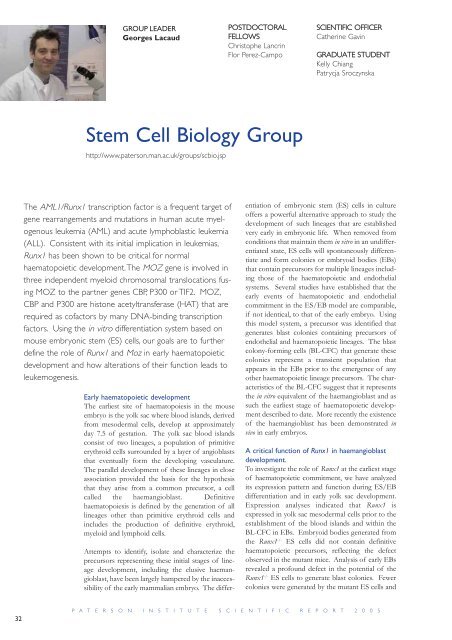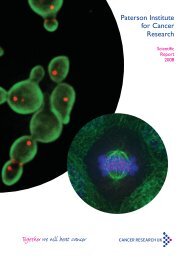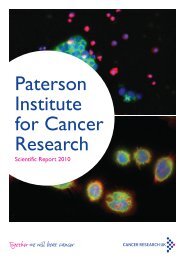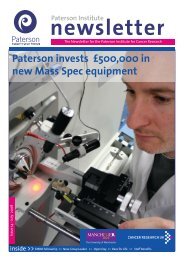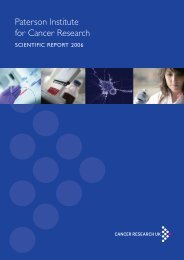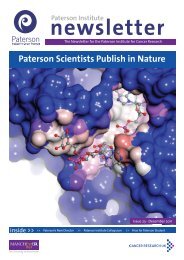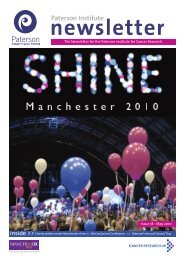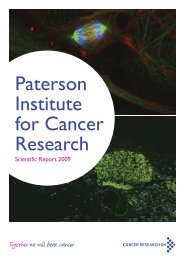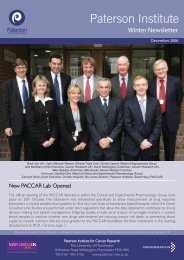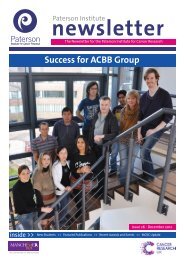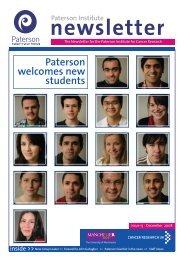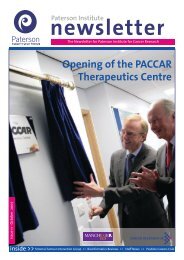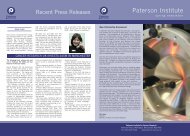Paterson Institute for Cancer Research SCIENTIFIC REPORT 2005
Paterson Institute for Cancer Research SCIENTIFIC REPORT 2005
Paterson Institute for Cancer Research SCIENTIFIC REPORT 2005
Create successful ePaper yourself
Turn your PDF publications into a flip-book with our unique Google optimized e-Paper software.
32<br />
GROUP LEADER<br />
Georges Lacaud<br />
Stem Cell Biology Group<br />
http://www.paterson.man.ac.uk/groups/scbio.jsp<br />
The AML1/Runx1 transcription factor is a frequent target of<br />
gene rearrangements and mutations in human acute myelogenous<br />
leukemia (AML) and acute lymphoblastic leukemia<br />
(ALL). Consistent with its initial implication in leukemias,<br />
Runx1 has been shown to be critical <strong>for</strong> normal<br />
haematopoietic development.The MOZ gene is involved in<br />
three independent myeloid chromosomal translocations fusing<br />
MOZ to the partner genes CBP, P300 or TIF2. MOZ,<br />
CBP and P300 are histone acetyltransferase (HAT) that are<br />
required as cofactors by many DNA-binding transcription<br />
factors. Using the in vitro differentiation system based on<br />
mouse embryonic stem (ES) cells, our goals are to further<br />
define the role of Runx1 and Moz in early haematopoietic<br />
development and how alterations of their function leads to<br />
leukemogenesis.<br />
Early haematopoietic development<br />
The earliest site of haematopoiesis in the mouse<br />
embryo is the yolk sac where blood islands, derived<br />
from mesodermal cells, develop at approximately<br />
day 7.5 of gestation. The yolk sac blood islands<br />
consist of two lineages, a population of primitive<br />
erythroid cells surrounded by a layer of angioblasts<br />
that eventually <strong>for</strong>m the developing vasculature.<br />
The parallel development of these lineages in close<br />
association provided the basis <strong>for</strong> the hypothesis<br />
that they arise from a common precursor, a cell<br />
called the haemangioblast. Definitive<br />
haematopoiesis is defined by the generation of all<br />
lineages other than primitive erythroid cells and<br />
includes the production of definitive erythroid,<br />
myeloid and lymphoid cells.<br />
Attempts to identify, isolate and characterize the<br />
precursors representing these initial stages of lineage<br />
development, including the elusive haemangioblast,<br />
have been largely hampered by the inaccessibility<br />
of the early mammalian embryo. The differ-<br />
POSTDOCTORAL<br />
FELLOWS<br />
Christophe Lancrin<br />
Flor Perez-Campo<br />
<strong>SCIENTIFIC</strong> OFFICER<br />
Catherine Gavin<br />
GRADUATE STUDENT<br />
Kelly Chiang<br />
Patrycja Sroczynska<br />
entiation of embryonic stem (ES) cells in culture<br />
offers a powerful alternative approach to study the<br />
development of such lineages that are established<br />
very early in embryonic life. When removed from<br />
conditions that maintain them in vitro in an undifferentiated<br />
state, ES cells will spontaneously differentiate<br />
and <strong>for</strong>m colonies or embryoid bodies (EBs)<br />
that contain precursors <strong>for</strong> multiple lineages including<br />
those of the haematopoietic and endothelial<br />
systems. Several studies have established that the<br />
early events of haematopoietic and endothelial<br />
commitment in the ES/EB model are comparable,<br />
if not identical, to that of the early embryo. Using<br />
this model system, a precursor was identified that<br />
generates blast colonies containing precursors of<br />
endothelial and haematopoietic lineages. The blast<br />
colony-<strong>for</strong>ming cells (BL-CFC) that generate these<br />
colonies represent a transient population that<br />
appears in the EBs prior to the emergence of any<br />
other haematopoietic lineage precursors. The characteristics<br />
of the BL-CFC suggest that it represents<br />
the in vitro equivalent of the haemangioblast and as<br />
such the earliest stage of haematopoietic development<br />
described to date. More recently the existence<br />
of the haemangioblast has been demonstrated in<br />
vivo in early embryos.<br />
A critical function of Runx1 in haemangioblast<br />
development.<br />
To investigate the role of Runx1 at the earliest stage<br />
of haematopoietic commitment, we have analyzed<br />
its expression pattern and function during ES/EB<br />
differentiation and in early yolk sac development.<br />
Expression analyses indicated that Runx1 is<br />
expressed in yolk sac mesodermal cells prior to the<br />
establishment of the blood islands and within the<br />
BL-CFC in EBs. Embryoid bodies generated from<br />
the Runx1 -/- ES cells did not contain definitive<br />
haematopoietic precursors, reflecting the defect<br />
observed in the mutant mice. Analysis of early EBs<br />
revealed a profound defect in the potential of the<br />
Runx1 -/- ES cells to generate blast colonies. Fewer<br />
colonies were generated by the mutant ES cells and<br />
P A T E R S O N I N S T I T U T E S C I E N T I F I C R E P O R T 2 0 0 5


